Wood-Mizer Sawmilling Systems Add Productivity and Save Operation Costs

Wood-Mizer Sawmilling Systems combine several sawmilling machines in one system to produce timber in a more controlled and efficient way. These systems are designed and customized for each customer and their specific requirements. They may range from the LT70 sawmill remote line to SLP1/SLP2 Smart Log Processing to the advanced Log Processing Sawmilling System. Wood-Mizer has an experienced and dedicated team of engineers to develop various sawmilling systems that produce more timber and less waste, reduce installation, operation, and maintenance costs, and lowering labor requirements.
Watch the online presentation of a sawmilling system featuring the LT70 HEAVY DUTY sawmill with a Remote Control station, the EG300 Multirip Board Edger, and the associated material handling equipment, including a log loading ramp, a sorting table, and a driven chain conveyor. The host of the presentation is Adam Kubiak, Wood-Mizer Industrial Sales Manager, one of the top engineers with Wood-Mizer.

The Wood-Mizer LT70 HEAVY-DUTY Sawmilling System
The LT70 HEAVY-DUTY sawmill joins the best features of two well-known Wood-Mizer machines – the LT70 sawing head and the industrial WM4000 sawmill bed. By combining these components in one robust unit, Wood-Mizer developed an efficient and fast sawmill while retaining low-cost maintenance and ease of operation.
"Wood-Mizer customers can choose between two types of sawing heads – the standard head with a cutting capacity max. of 95 cm log diameter and the wide head with a cutting capacity max. of 105 cm log diameter," explains Adam Kubiak.
The sawing head is powered by the standard electric motor 18,5 kW (25 HP) or optionally by 22 kW (30 HP).
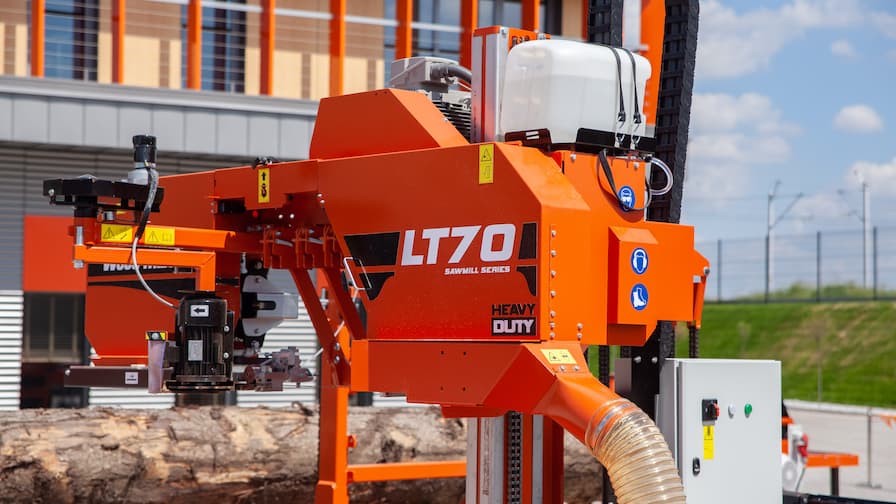

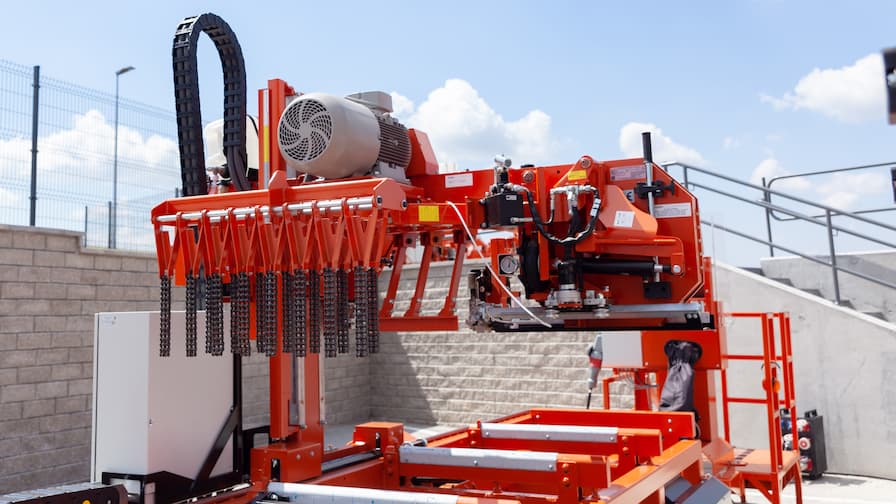
The distance between the blade guide rollers is 73 cm on the standard head and 86 cm on the wide, which means that the maximum cant width can reach 64 cm and 78 cm, respectively. Two 24-inch (over 600 mm) belted blade wheels use 38 mm wide and 477 cm long sawmill blades. There are two blade guides, the left one is moveable (and paired with the LubeMizer cleaning unit), and the right one is fixed. "The standard blade guide has a roller which deflects the blade about 6 mm, and two guiding blocks support it. This solution provides much precision during the cutting," says Adam Kubiak.
"The recommended blade tension parameters are informed on the sticker, next to the manual hydraulic pump. Sometimes sawmillers add too much tension to the blade when they can't get a straight cut. We don't recommend it, as it affects the blade life, head performance, bearings, etc. Instead, the operator should check if the blade is sharpened and set correctly, or if the blade guide and blade wheels are well adjusted," reminds Adam.


A Clear View from the Remote Control Station
The LT70 HEAVY-DUTY sawmill has a remote control station located conveniently at the beginning of the line, allowing the operator a clear view of the sawing process. "On the left side of the log, the operator sees the log clamp and log turner, and on the right, he sees the vertical side supports. The control station sets up in a convenient place near the sawmill. For a better visibility, we recommend installing the control panel on an elevation," instructs Adam Kubiak.
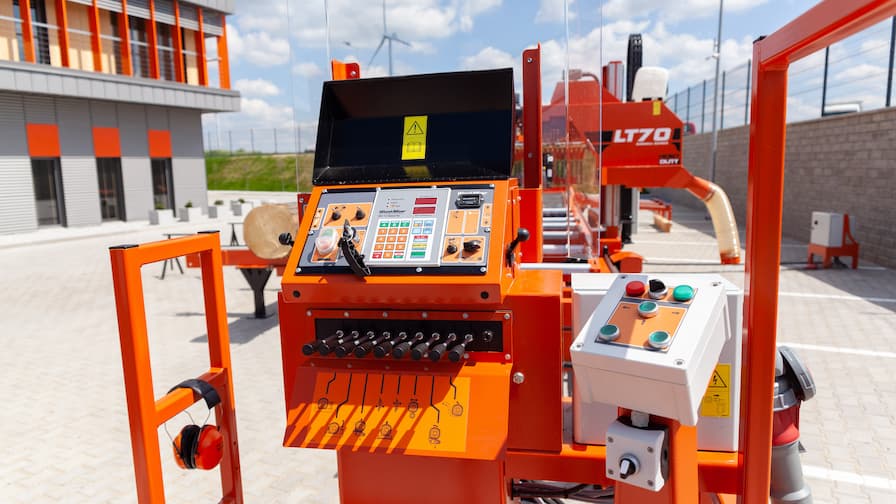
The operator panel features the following control functions:
- A power feed drum switch
- A potentiometer for adjusting sawing speed
- A drum switch for sawhead up/down
- Two buttons for starting and controlling the debarker
- A switch for adjusting the blade guide arm
- SW10 Setworks for automatic board thickness adjustments.
Customers can select one of three types of electronic control units – an SW10 Setworks, Accuset, or a PLC control module.
The sawing head connects with the operator station by electric cables in a flexible cat track or curtain. "When you have some extra space in the workshop, it's a good idea to have the electric cables installed on a curtain with steel posts because in this case, the cables remain clean from the sawdust. If you decide on a cat track, you have to take some effort to clean up the cables after each work shift," explains Adam.
The HEAVY-DUTY bed
The bed from the WM4000 sawmill transforms the standard LT70 sawmill into an industrial machine. "The steel tube itself is the same across all Wood-Mizer sawmill models – from the LT20 up to the WM4000, but the difference is in bed cross-section design," explains Adam. "Here, the bottom part of the section is very solid with thick steel plates. These sections are adjustable. They are roof-top shaped, additionally stiffened, and three bolts support every bed section. These bolts are not only for strengthening but also for aligning the bed. The construction was designed for very tough industrial operations, and it's almost impossible to damage it physically," assures Adam Kubiak.
The industrial bed features a set of hydraulic equipment for easier handling of large and heavy logs. There are two standard hydraulic packages – the AHSH2 and the AHSH4. The simpler one, AHSH2, consists of 3 vertical side supports, each built on a double rod made from high-carbon steel with chromium coating and the main clamp on a double rod. There is also a log turner and two power rollers supported by two hydraulic cylinders for controlling and positioning the log on the bed.


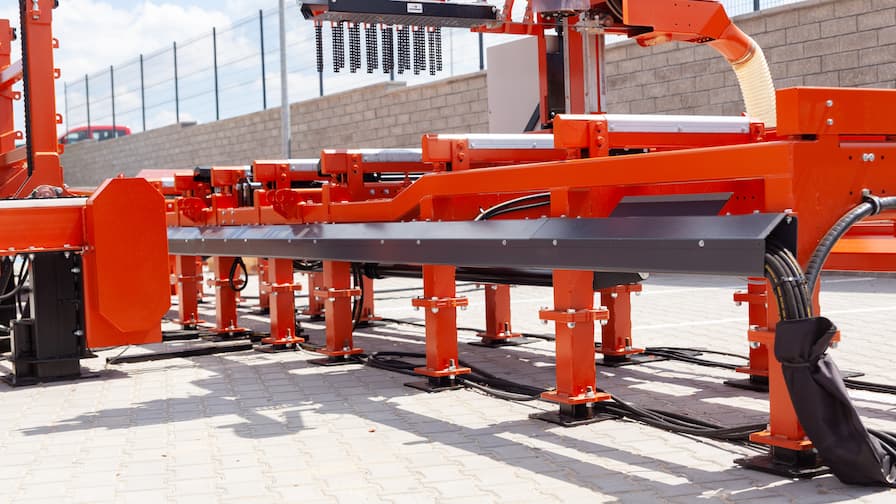
"In the AHSH4 hydraulic pack, the customer also gets a set of pull-down clamps that are useful when you cut long logs. After releasing the stress accumulated in the wood, the cants might be deformed. With these clamps, you can hold the material flat on the bed and cut the material straight," explains Adam.
The LT70 HEAVY-DUTY has a board removal system with special fingers and chains for removing the ready boards automatically from the sawmill and a short conveyor belt for transferring the ready timber to the next equipment such as the sorting table in this example.
The Material Handling and Timber Processing Equipment
The LT70 HEAVY-DUTY sawmilling system includes several accessory machines for log processing automation:
• a log loading deck
• a sorting table
• a chain conveyor
• EG300 Multirip Board Edger.
The loading deck is available in two lengths - 3,6 m and 6 m, and in two widths – 1,55 m and 3,8 m. "The deck may be equipped with 2 or 3 transportation chains to feed irregularly shaped logs or short material," informs Adam Kubiak.


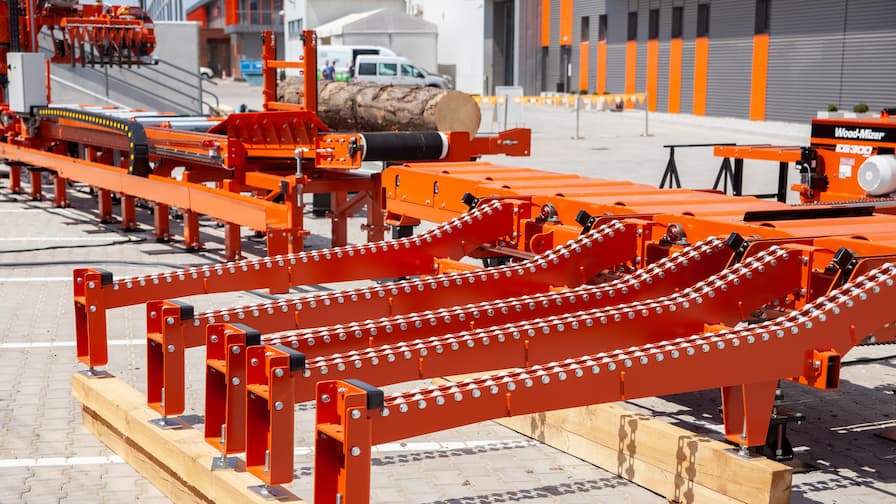
The sorting table consists of 3-meter-long modules with an option to extend it up to 9 m. Each module features heavy-duty power rollers to transport the material forward and cross-chains for directing the material to the left or right side. This configuration has a gravity slide on the right side and a chain conveyor forwarding material from the sawmill to the edger on the left side. It's 2,4 m long with three chains, but Wood-Mizer can redesign it according to customer needs.
At the end of the line, there's the EG300 board edger. This machine is available with two types of electric motor - 15 kW (20 HP) and 18 kW (25 HP). It can process boards up to 60 mm of thickness. The edger has two circular blades; the first one works in a fixed position, and the second one is moveable and equipped with a laser sight for better visual control of the edging process. It is possible to add up to 5 blades on the shaft and operate a multirip machine.
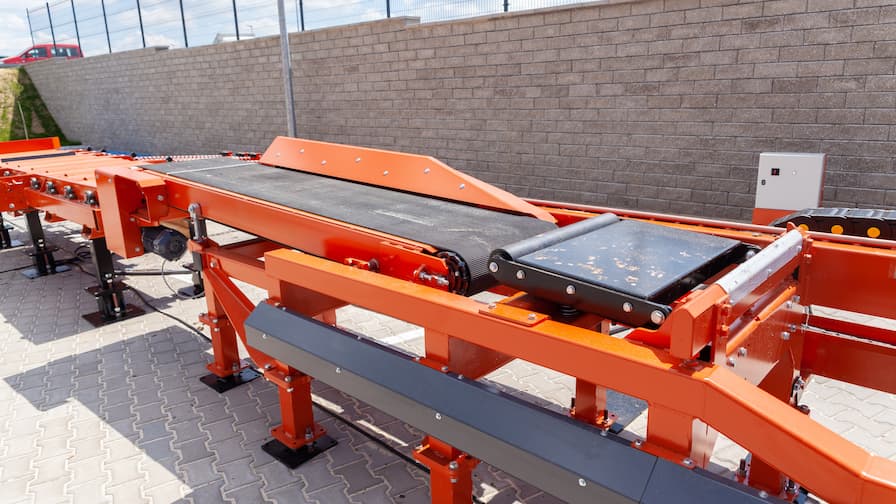
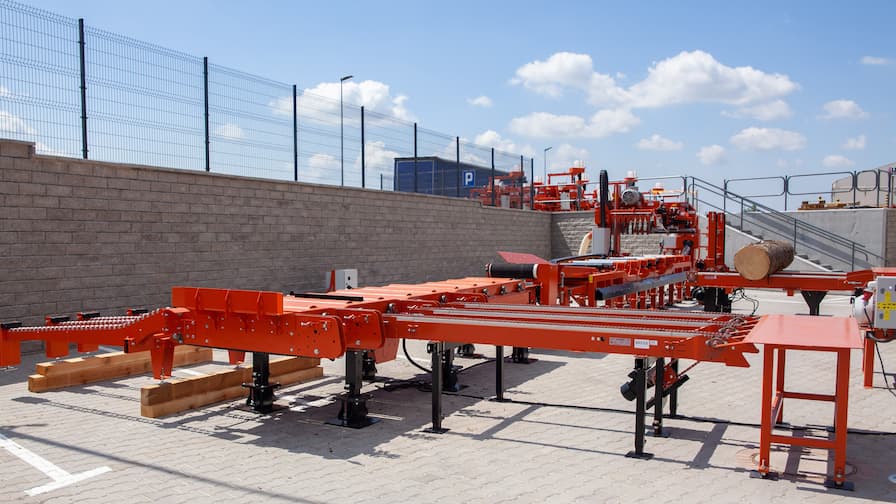
Customized Sawmilling Line Configurations
The process begins with log loading to the sawmill bed using the log deck. Once the log is on the bed, the operator uses the hydraulic log turner and power rollers to position it optimally for the initial cut. Then the operator activates the blade and the debarker. After making the initial cut, the slab is moved backward by the board removal fingers and chains to the short conveyor belt. It automatically passes the slab to the sorting table, and from there, it's directed to the right side, to the gravity slides. The process repeats for the next cut, but the unedged slab goes to the left side, to the EG300 board edger. The operator can easily make edged boards with definite width, as the EG300 has the laser sight.
Customers can further upgrade the sawmilling lines by adding more units, for example, adding a chain conveyor transporting the slabs from the sorting table to the right to the MR200 Double Arbor Multirip for further productivity increase.
Wood-Mizer Sawmilling Systems allow for the gradual expansion of the production line, improving its performance and raising it to a high industrial level.
If you would like to learn more about the best sawmilling system for your application, please contact the local Wood-Mizer Sawmilling Specialist at https://woodmizer.eu/contact
***
